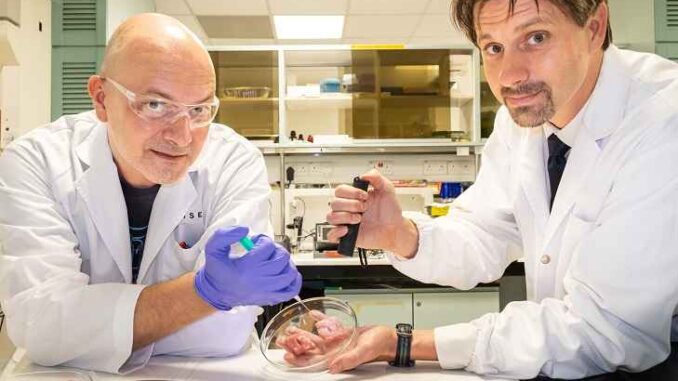
Views: 4
– Material scientists at Nanyang Technological University, Singapore – NTU Singapore, have invented a new type of surgical glue that can help connect blood vessels and close wounds more quickly and can also serve as a platform to provide pain relief drugs.
Courtesy by NTU: In an article published in Elsevier’s Biomaterials in July, together with doctors at Singapore General Hospital (SGH), NTU researchers showed that their glue can join soft tissues, including muscles and blood vessels, even when their surfaces are wet .
Called CaproGlu, it is activated by a low dose of ultraviolet (UV) light that cures it in seconds, transforming it from a liquid glue into a solid but flexible bio-rubber – a biocompatible material that can be reabsorbed by the fabric after a few weeks.
The team showed in animal experiments that blood vessels can be rewired with just four stitches and a mesh wrap dipped in CaproGlu, compared to the usual eight stitches that are needed for a reliable and unobstructed joint. The authors estimate that this will cut surgery time by 25 percent, as surgeons spend less time and effort sewing blood vessels and tissues.
As shown in animal experiments, CaproGlu can also be used to deliver local anesthetics or pain relief medications to body tissues, which can be useful during and after an operation and would reduce the need for painkillers afterwards.
Unlike current bioadhesives – which need two chemicals to be mixed before use – CaproGlu is a liquid gel solution from a container that comes ready for use.
Leading authors of the article, associate professor Terry WJ Steele and senior researcher, Dr. Ivan Djordjevic, emphasized that most surgical adhesives available on the market do not work in water or wet environments like those found in the human body.
“To make our light-activated glue work on damp fabrics, we designed our glue to first remove water from the surface and thus allow it to adhere to dehydrated surfaces,” said Assoc Prof Steele.
“This unique advantage of being able to bond with high resistance in a humid environment, in addition to being biocompatible, is what makes CaproGlu so suitable for use in surgery and medical applications.”
The adhesion strength of CaproGlu was compared with other commercial bioadhesives on the market and was considered three to seven times stronger and is at the same level as the shear strength of collagen and muscle tissue found in the human body.
Benefits of CaproGlu
Invented by Assoc Prof Steele and Dr. Djordjevic of NTU School of Materials Science and Engineering, CaproGlu combines two ingredients in a single component formulation that does not require additives.
The first is polycaprolactone – a biodegradable polymer approved by the United States Food and Drug Administration for specific applications in the human body – and the second: diazirine, a photosensitive molecule that can form strong bonds when activated.
In their research article published in the scientific journal Biomaterials, the scientists demonstrated how CaproGlu can be used as part of a new surgical method, where sutures are used in combination with a glue. Instead of the eight conventional points needed to join the two ends of a blood vessel in a rabbit, they used four points and wrapped the ends of the vessel with a biodegradable mesh dipped in CaproGlu and cured with a small dose of UV light that reticulated the amino acids on the fabric surface
As a result, bleeding from the artery immediately after the procedure was comparable to that seen in conventional stitches. When harvested seven days later, the artery was completely healed.
In a separate experiment, surgeons inserted CaproGlu loaded with anesthetics into rat calves and healed them with ultraviolet light before the wound was closed with conventional stitches.
The scientists compared the activity of these mice to two other controls: mice that received only anesthetics and mice that received CaproGlu without anesthetics. They found no discernable movement impediment for rats that received anesthetics and CaproGlu loaded with anesthetics, suggesting that CaproGlu is successful in administering local anesthetics over time and may be a useful way to extend local anesthesia beyond its limits. current limits and also act as a drug distribution platform for drugs, such as anticoagulants, to prevent excessive blood clotting.
The team also noted that there were no noticeable side effects in animals that have CaproGlu implanted in their skin, which suggests that it is safe and biocompatible as expected. Once the bioadhesive dissolves and is reabsorbed in weeks, no follow-up clinical consultation would be necessary for its removal.
Stable service life after sterilization
A major challenge for bioadhesives on the market today is dealing with the standard method by which surgical-grade and disposable equipment is sterilized by gamma irradiation.
The gamma sterilization process destroys proteins and activates binding in acrylate and epoxy adhesives.
Unlike other surgical adhesives available on the market, CaproGlu’s protein-free formulation explores the new cross-linking chemistry unaffected by gamma sterilization.
The light-activated binding mechanism forms nanoscale-level chain bonds for amino acids, even after several months of gamma storage and sterilization, making the production and commercialization of CaproGlu potentially less expensive than those based on proteins and acrylates.
Its innovation in biorubber glue took five years for the research team to develop and is the subject of a provisional patent registered by NTUitive, the university’s innovation company and company.
Funding and support for the project includes the NTU-Surgery Academic Clinical Program Strategic Joint Research Fund, Singapore General Hospital Research Grant, NTU-Northwestern Institute for Nanomedicine Grant, NTUitive Proof of Concept (Gap) Fund, Fund of Industry Alignment A * Star (Pre-Positioning) and the Tier 1 and 2 research fund of the Ministry of Education.
Moving forward, the joint team will seek to conduct more animal experiments and evaluate the performance of CaproGlu in other applications, such as on bones and other organic surfaces.
REF: “CaproGlu: multifunctional tissue adhesive platform”, published in Biomaterials, 11 July 2020.
Related article: How to mend a broken heart with mussels